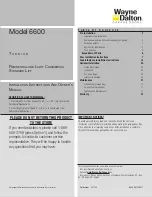
3
EN
3.2 -
Installation of gearmotor
WARNINGS
• Incorrect installation may cause serious physical injury to
those working on or using the system.
• Before proceeding with the installation, refer to par. 3.1.
01.
Identify the front and rear bracket mounting positions (
fig. 3
)
02.
Secure the rear bracket with reference to its specified installation
positions (
fig. 3
)
03.
Mount the gearmotor to the rear bracket (
figg. 5 / 6
)
04.
Manually release the gearmotor (
fig. 7
)
05.
Pull the rod completely out (
fig. 8 - a
)
06.
Provisionally locate the front bracket onto the gate (
fig. 8 - b
)
07.
Check that the gearmotor is level, then fit and secure the rod to
the front bracket (
fig. 8 - c
)
08.
(
fig. 9
) Check manually that:
- when the gate is fully open, it halts against its mechanical stops
- the gate swings freely and without resistance
Correct any defect
09.
Unhook the rod from the front bracket (
fig. 10 - a
) and mount the
latter to the gate definitively (
fig. 10 - b
)
10.
Definitively mount the rod to the front bracket (
fig. 10 - c
)
11.
Lock the gearmotor (
fig. 11
)
Run this procedure for both gearmotors.
3.3 -
Manually releasing the
gearmotor (fg. 7)
01.
Raise the rubber cap (
fig. 7 - a
)
02.
Fit the provided wrench and rotate it CW by 90° (
fig. 7 - b
)
Run this procedure for both gearmotors.
3.4 -
Manually locking the gearmotor
(fg. 11)
01.
Move the gate to the halfway open position by hand
02.
Raise the rubber cap (
fig. 11 - a
)
03.
Fit the provided wrench and rotate it CCW by 90°(
fig. 11 - b
)
Run this procedure for both gearmotors.
4.
Electrical connections
CAUTION!
– Incorrect connections can cause faults or hazards; therefo-
re ensure that the specified connections are strictly obser-
ved.
– Hook up the unit with the electrical power shut off.
01.
Remove the gearmotor’s cover (
fig. 12 - a
)
02.
Loosen the cable clamp (
fig. 12 - b
) and run the cable through it
(
fig. 12 - c
)
03.
Hook up the cables and connect the earth cable to its eyebolt
(
fig. 13
)
04.
Tighten down the cable clamp and restore the cover (
fig. 14
)
5.
Automation testing
This is the most important stage in the automation system installation
procedure in order to ensure the maximum safety levels. Testing can
also be adopted as a method of periodically checking that all the
various devices in the system are functioning correctly.
Testing of the entire system must be performed by qualified
and experienced personnel
who must establish which tests to
conduct on the basis of the risks involved, and verify the compliance
of the system with applicable regulations, legislation and standards,
in particular with all the provisions of EN12445 which establishes the
test methods for automation systems for gates.
5.1 -
Testing
Each component of the system, (safety edges, photocells, emer-
gency stop, etc.) requires a specific testing phase. To do so, follow
the procedures given in the instruction manuals.
01.
Ensure that the instructions outlined in this manual and in particu-
lar in chapter 1 have been observed in full.
02.
Manually release the gearmotor (
fig. 7
)
03.
Make sure you can move the door manually both during opening
and closing with a force of max. 390 N (40 kg approx.).
04.
Manually lock the gearmotor (
fig. 11
)
05.
Hook up the electrical power supply
06.
Use the control or stop devices to test the opening, closing and
stopping of the gate and that it behaves as intended.
07.
Check the operation of all safety devices, and check that the gate
performs as it should.
08.
Activate a closing manoeuvre and check impact force of the door
against the mechanical stop. If necessary, reduce the pressure for
better adjustment
09.
If the dangerous situations caused by the movement of the gate
have been safeguarded by limiting the impact force, the user must
measure the impact force according to EN12445.
Note
– The gearmotor’s torque cannot be adjusted directly: this
adjustment is done by the control unit.
5.2 -
Commissioning
Commissioning may only be done when all the gearmotor tests spe-
cified in par. 5.1, and those of the other equipment, have been pas
-
sed: to commission the unit, refer to the control unit manual.
IMPORTANT - It is not permissible to execute partial commis-
sioning or to enable use of the system in makeshift conditions.
Summary of Contents for LINEAR400230
Page 5: ...5 a b 6 a b 7...
Page 6: ...MAX a c b 8 9 a c b 10 OPTIONAL...
Page 7: ...a b 11 a c b 12...
Page 8: ...24V 230V 13 b a 14...
Page 14: ......




































